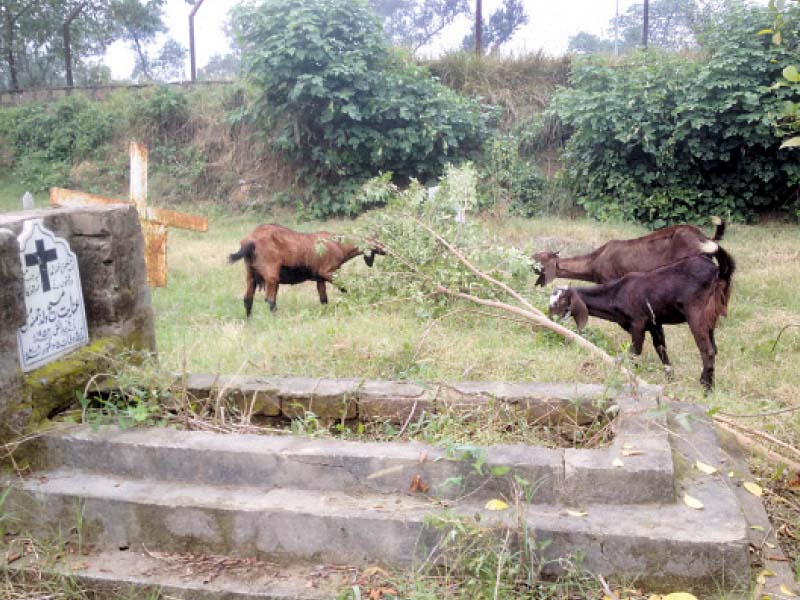
And that is when we see the very mundane settings of our loved ones’ final abode.
Although graveyards in the capital are numerous, four fall under the jurisdiction of the city’s civic agency. Goats and cows roam freely in the lush green space of the new Christian cemetery in H-9, eating wild shrubs growing on the graves.
Groundskeeper Waris Masih says he has no means to stop local livestock herders from grazing animals there. Ajid Masih, a teacher, said he had buried his uncle the day before, and has to pay to keep the graves of loved ones clean. “I pay between Rs10 to Rs20 a month. Some months I only make Rs400. I can’t afford more than this.” Nathan John, a priest, said he hoped that issues such as a low-lying barbed wire fence, which funeral processions must precariously cross under to bury the dead, will be resolved.
 PHOTO: EBRAHIM UMAR-KHITAB/EXPRESS
PHOTO: EBRAHIM UMAR-KHITAB/EXPRESSNestled between farmhouses, the derelict older Christian cemetery was the abode of Najeer Masih, Waris’ father and a former groundskeeper. “Other authority-run graveyards are staffed for three shifts. We have two people,” he said. Najeer told The Express Tribune that the quarters on site had been allotted to a driver at the Capital Development Authority (CDA) chairman’s office, rather than cemetery staff.
In contrast, the Baha’i cemetery bordering the Christian and Mirzai graveyards was a pristine space, tended to by Muhammad Riaz, a caretaker who was hired privately by the community. The grounds are not under CDA control.
Razi Haider, a retired educator, was visiting his mother’s grave at the H-11 graveyard, the final resting place for around 18,000 people. He said horticulture staff will only clean the grave if they are paid Rs100. Similar sentiments were expressed by Humaira Malik, a government employee from Lahore, who buried her mother there six months back. “I have yet to see them doing their jobs today,” she said, adding that her father used to pay Rs500 a month to keep the grave clean. Not everyone sees this as a matter of opportunism. Kashif Saboor, a businessman, said he happily pays Rs500 to keep his father’s grave clean.
Graveyard staff, who all requested anonymity, assert that the matter is under control. “The CDA has assigned 15 undertakers and as many cleaners for the sites.” He did concede that citizens were asked to bring their own lights for night funerals, pointing to the unmaintained lighting at the cemetery.
Things were much the same at H-8, where 40,000 people are buried. Senior officials claim they lack office equipment, quarters and other benefits, which impacts their performance. When asked about the inadequate cleanliness at the site, the official in charge exclaimed, “You know the culture of our people – they even expect the CDA to wash the graves of their fathers.”
Multiple graveyard officials echoed concerns that care of the sites was to be handed over to the municipal department after local government elections in the capital on November 30, leaving their futures uncertain. This comes as no surprise in a country where the plight of the living can seem a far more pressing reality than the state of burial grounds.
 Picture shows destroyed grave of a four-year-old child. PHOTO: EBRAHIM UMAR-KHITAB/EXPRESS
Picture shows destroyed grave of a four-year-old child. PHOTO: EBRAHIM UMAR-KHITAB/EXPRESSDignity for the dead seems reserved for parts of the world where lower birth and death rates afford for trimmed shrubs and manicured lawns.
An official said it best, urging The Express Tribune to “write stories about the living, not the dead.”
Published in The Express Tribune, November 22nd, 2015.








1726732405-0/Express-Tribune-Web-(15)1726732405-0-270x192.webp)








COMMENTS
Comments are moderated and generally will be posted if they are on-topic and not abusive.
For more information, please see our Comments FAQ